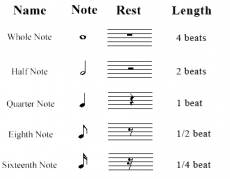
To begin, I suggest that if you haven’t read Music Theory Part 1, you go back and read this first, as otherwise you’ll be confused by my skipping ahead. If you’ve already read and understood the ideas in the previous article, then now we’re going to move on to focussing on timing and rhythm in music.
We already know that where about the dots are placed on the staffs tells us what note to play, but now we need to know how long to hold each note for. We can work this out based on the type of dot that is used on the staff. Each type of dot tells us a different length of time to hold a note for.
Before I explain the different note lengths, I should probably first mention that the lengths of notes are all relative. What I mean by that is that all music has a rhythm. You may have heard this term before, but not really understood what it means. Primarily, it means that all music is separated into beats. Often this will be clear from a song because of what the drums are doing in the background, but if not I’ll try and explain it more simply. If you try counting along to a piece of music, you’ll probably find yourself naturally fitting to a certain tempo (or speed), which fits nicely with the music. If you play a faster or slower song, you’ll probably find that you’re counting changes accordingly. That is because the rhythm has slowed down. There are less beats per minute, and you are trying to keep your counting in time with the ‘beats’. It was important to explain this, since in the music, it will not tell you literally how long to hold each note for, but it will in fact say how many beats to hold a note for.
You can hold the note for the same number of beats in a fast song and a slow song, but the actual length of time you are holding the note down for will be different. To know how long each beat should be held for, you have to also know the tempo of the song, which will usually be given in number of beats per minute.
Having explained this, there are several different types of dot, which will each symbolise holding that note for a certain number of beats. The crotchet - a coloured in dot with a stick going either upwards or downwards from it represents a single beat, the minim - an empty dot with a stick represents holding a note for two beats, and the semibreve – an empty dot with no stick represents holding a note for four beats. Not all notes have to last a beat either. Generally, the overall rhythm of a song will follow the beat pattern, but there can also be smaller notes, within these beats, and some notes will overlap between beats, going against the flow of the song. This is known as syncopation.
Quavers are coloured in dots with a stick that also has a tail. Often the tails are joined together if there are many quavers in a row. Quavers tell the instrumentalist to play for half a beat. Semiquavers are similar but with two tails coming of the stick. These are worth a quarter of a beat. Notes can be tied together with a curvy line, which can be used to make them overlap between beats to achieve the syncopation mentioned above.
There are also rests where you do not play anything. The quarter rest, which is held for one beat is a sort of a squiggly line in the middle of the staff. The half rest is a block attached to the bottom of the third gap in the staff. This is worth two beats, and the whole rest, worth four beats is shown by a block attached to the top of the third gap in the staff. An eighth rest, worth half a beat, is a stick with a small tail at the top, and the sixteenth rest, worth a quarter of a beat is the same but with two tails.
This is a fairly comprehensive explanation of the timings of the different notes and rests and how they fit together in a piece, but it’s still missing one thing, which is the time signature. Quite a complex concept to get your head around, I’ve saved this for a separate article, but until then, if you do have an instrument in your house, ideally a piano or keyboard, I challenge you to go and find out a little more about using that instrument, and then to try and play a few notes with the knowledge you’ve learnt so far.
Image from: http://musictheoryisyourfriend.com/wp-content/uploads/2013/08/note_rest_look_length.jpg

0 Comment:
Be the first one to comment on this article.